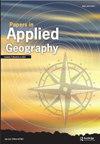Dollar Store Access in the St. Louis Metropolitan Area, MO-IL, USA
Q2 Social Sciences
引用次数: 1
Abstract
Abstract Most food accessibility research focus on stores that sell healthy food such as grocery stores compared with stores that sell unhealthy food such as fast-food retailers. These studies overlook the fastest growing retail segment in the United States, dollar stores. Although dollar stores might not be known for their food items, their ubiquitous nature in our retail environment forces many to use dollar stores as their primary and often closest food source. This study evaluated dollar store access in the St. Louis Metropolitan Statistical Area (MSA) based on count analysis and travel time along with demographic variables such as income and education. Results reveal that a majority of tracts in the St. Louis MSA do not have a dollar store, yet over half the residents of the MSA live within a five-minute drive of a dollar store. Rural residents live the farthest from a dollar store, with one population-weighted tract centroid traveling over twenty minutes to a dollar store. Demographic results reveal that dollar stores tend to locate in places with lower incomes, lower levels of education, and more diverse residents. The growth of dollar stores across the United States allows for residents to have easier access to goods, but concern exists regarding the healthiness of the food products served in these stores. Future research will include health data to determine if these stores could be contributing to the obesity and diabetes epidemics in the United States.美国密苏里州圣路易斯大都会区的一元店通道
大多数食品可及性研究集中在销售健康食品的商店(如杂货店)和销售不健康食品的商店(如快餐零售商)之间。这些研究忽略了美国增长最快的零售部门——一元店。虽然一元店可能并不以其食品而闻名,但它们在零售环境中无处不在的特性迫使许多人将一元店作为他们的主要和通常最近的食物来源。本研究基于计数分析和出行时间以及收入和教育等人口变量,评估了圣路易斯大都会统计区(MSA)一元店的使用情况。结果显示,圣路易斯MSA的大部分地区都没有一元店,但超过一半的MSA居民住在距离一元店五分钟车程的范围内。农村居民住得离一元店最远,一个人口加权的区域中心点到一元店需要20多分钟。人口统计结果显示,一元店往往位于收入较低、教育水平较低、居民多元化程度较高的地方。美国各地一元店的增长使居民更容易获得商品,但人们对这些商店供应的食品的健康存在担忧。未来的研究将包括健康数据,以确定这些商店是否可能导致美国的肥胖和糖尿病流行。
本文章由计算机程序翻译,如有差异,请以英文原文为准。
求助全文
约1分钟内获得全文
求助全文

 求助内容:
求助内容: 应助结果提醒方式:
应助结果提醒方式:


